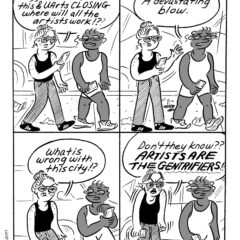The exhibit Young Country at UArts‘ Rosenwald-Wolf Gallery is as slippery as its title. Are we talking deep South? The Wild West? Our dreams as a baby nation only 225 years old? Either way, we are talking about something American in the bone, a kind of iconic ur-culture exaggerated by movies and stereotypes to they point that they have become our reality of the imagination.
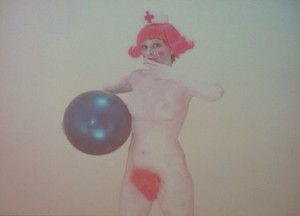
For all that, the show is full of some wonderful moments by non-country artists looking toward the west and south and piney woods as well as country artists gazing at the culture in which they find themselves immersed.
My favorite videos were Janine Harkleroad’s The Duel and Richard Campbell’s Horses are Pretty.
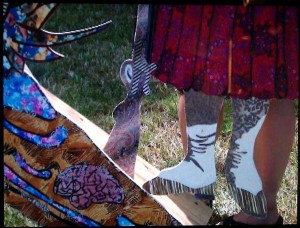
Harkleroad’s The Duel is a shoot-out between two life-size cut-out props, one representing Annie Oakley and one The Cowboy. The competition has feminist Annie shoot off her mouth as well as her piece, amid a quirky stage set that includes quilted backdrops and a mix of drawings and fabrics. Fun to look at, fun to listen to. Plus the story goes contemporary and domestic in its war between the sexes.
A nice contrast is Campbell’s My Little Pony porno. Betty the Nurse wears a Pony-pink wig and an enormous swatch of Pony-pink pubic hair at the base of her belly and at times not much else, in a send-up that plays with pre-teen girls’ obsession with real studly steeds and grown boy sex fantasies of nurses in and out of uniform. Yet somehow the end product is not so much dirty as funny and pleasantly odd.
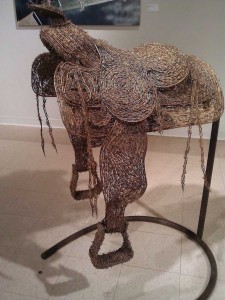
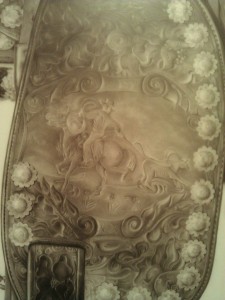
Speaking of steeds, the show saddles up twice–with Mel Chin’s Rough Rider, a saddle beautifully crafted of barbed wire and steel (ouch; for cowpokes no doubt), and with Marshall Harris’ tour-de-force graphite on mylar drawing, Saddle Sketch, notable for turning the leather embossing into a romantic Wild West landscape. The contrast between the two is worth some thinking.
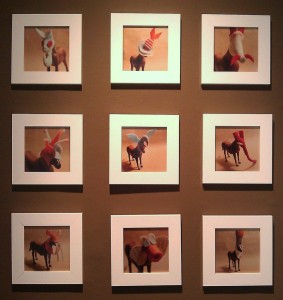
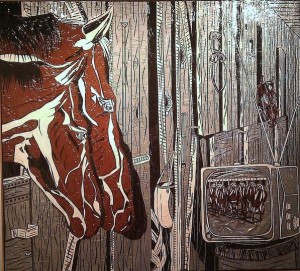
In Philadelphia artist Joe Girandola’s duct-tape on canvas portrait of a horse watching a televised horse race, the monumental beast of a horse is a humanized and sad creature, tamed in the stable. And humanized animals sporting ridiculous hat fashions in Suki Anderson’s series Mr. Nibbles Likes to Wear Hats goes even further off the beaten path. The nine digital images are amusing, a la poodles in raincoats, but far less conventional and just a little creepy with suggestions of lives of enslavement and bondage for our four-footed friends.
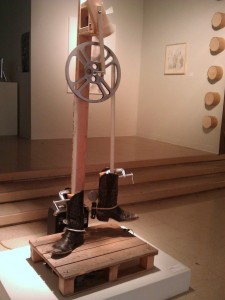
For another fashion statement and then some, C. Grant Cox’s Tense Negotiations is a gizmo with stomping cowboy boots, disembodied but still dancing their way in (or out) of the Long Branch Saloon and their not drunk on sarsparilla. It delights at the same time that it iconifies something already iconic–all those heroic and villainous characters who live and die in their boots in a century of Hollywood oaters. This is a show with lots of boots and lots and lots of gunfights.
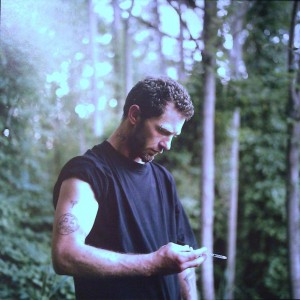
The only shot in a photo by Philadelphia photographer Jeffrey Stockbridge is from a syringe, suggesting a drug-infused slow death in contemporary rural life. The show does get beyond the conventions of cowboys, and spends a little time on the farm and in the woods, North and South. I loved the Matthew Weddington’s conceptual road sign, too.
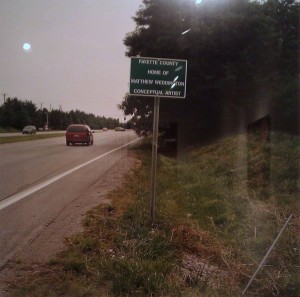
The show has barns, a still, rope, and other country conventions to poke. I’m not so sure the show achieves a new definition of what “country” means, but it’s having an awfully good time playing with the old definitions, and moving the art conversation out of New York.
The show’s 22 artists come from around the country, and Delaware Center for Contemporary Art Curator Maiza Hixson said she hopes to travel the show some more. For now, it opened in Louisville, and came here. The next venue is still in the planning stage. This is DCCA’s first ever “satellite” show, a DCCA-curated show especially for off-site exhibition.
Young Country
Rosenwald-Wolf Gallery
333 S. Broad Street
to July 29
Monday – Thursday: 10 a.m. – 5 p.m.
Friday: 10 a.m. – 4 p.m.





